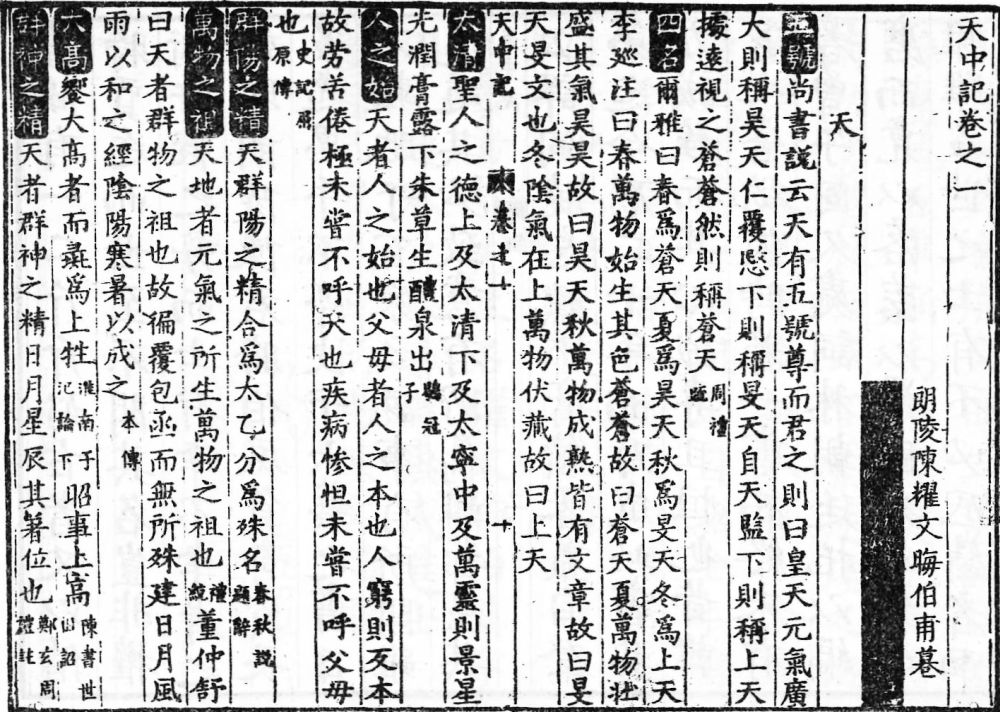Tianzhongji 天中記 "Records from Mt. Tianzhong" is an encylopaedia compiled during the Ming period 明 (1368-1644) by Chen Yuewen (Chen Yaowen) 陳躍文, who lived on Mt. Tianzhong (i.e., Mt. Tiantai 天臺山), hence the title of the book. It is also called Songhai huibian 宋海彙編. Chen Yaowen also wrote the books Jingdian qiyi 經典稽疑 and Xuelin zhengjiu 學林正就.
The Tianzhongji was finished in 1589 after twenty years of compilation. It has an appendix containing a rhapsody on astronomy by the Han-period 漢 (206 BCE-220 CE) writer Zhang Heng 張衡 (78-139) called Zhoutian daxiang fu 週天大象賦. The first printed version is 50 juan long, and a version from the late 16th century 60 juan, covering 796 topics. The book is only divided into small categories without prominent headlines.
 |
Reprint by Taibei Wenhai Shuju 臺灣文海書局, 1964. Translation see below. |
| 【五號】《尚書說》云:天有五號,尊而君之,則曰皇天。元氣廣大則稱昊天。仁覆愍下則稱旻天。自天監下則稱上天。據遠視之,蒼蒼然,則稱蒼天。(周禮疏) | The Five Designations. The Explanations to the Classic Shangshu "Book of Documents" say, "There are five designations for Heaven. When it is revered and rules over all, it is called the Sovereign Heaven. When its primordial energy (yuanqi 元氣) is vast and expansive, it is called the Vast Heaven. When it shows compassion and mercy (愍 /mĭĕn˥/) towards the lower beings, it is called the Profound (旻 /mĭĕn˩/) Heaven. When it observes and governs from above, it is called the Heaven Above. When it appears distant and boundless, looking azure and endless, it is called the Azure Heaven. (From Zhouli shu) |
| 【四名】《爾雅》曰:春為蒼天,夏為昊天,秋為旻天,冬為上天。李巡注曰:春萬物始生,其色蒼蒼,故曰蒼天。夏萬物壯盛,其氣昊昊,故曰昊天。秋萬物成熟,皆有文章,故曰旻天。旻,文也。冬陰氣在上,萬物伏蔵,故曰上天。 | The Four Names. The glossary Erya says: Spring corresponds to the Azure Heaven, Summer to the Vast Heaven, Autumn to the Profound Heaven, and Winter to Heaven Above. Li Xun's (late 2nd cent. CE) commentary says: In Spring, all things begin to grow, and their color is azure, so it is called the 'Azure Heaven'. In Summer, all things thrive and become full of vitality, and their energy is vast, so it is called the 'Vast Heaven'. In Autumn, all things mature and display their patterns, so it is called the 'Profound Heaven'. 'Profound' (旻 /mĭĕn˩/) means 'pattern' (文 /mĭuən˩/). In Winter, the Yin energy (yinqi 陰氣) waxes, and all things lie dormant, so it is called ‘Heaven Above’. |
| 【太清】聖人之徳,上及太清,下及太寧,中及萬靈,則景星光潤,膏露下朱,草生醴泉出。(鶡冠子) | The Supreme Purity. The virtue of the sage reaches up to the Supreme Purity, down to the Supreme Tranquility, and extends to all the spirits of the world. Then, the luminous star of good fortune shines, the nourishing dew falls, the grass grows, and the sweet spring emerges. (From Heguanzi) |
| 【人之始】天者,人之始也。父母者,人之本也。人窮則反本,故勞苦倦極,未嘗不呼天也。疾痛慘怛,未嘗不呼父母也。(史記•屈原傳) | The Origin of Mankind. Heaven is the origin of humanity. Parents are the foundation of humanity. When a person is in despair, they return to their roots. Thus, when exhausted by labour and weariness, they inevitably call out to Heaven. When in sickness or extreme pain, they inevitably call out to their parents. (from the Biography of Qu Yuan in the Shiji) |
| 【羣陽之精】天羣陽之精,合為太乙,分為殊名。(春秋說題辭) | The Essence of the Myriad Yang Energies. Heaven is the essence of the myriad Yang energies, which combine to form the Great Unity, and are then divided into distinct names (individual things). (From Chunqiu shuo tici) |
The Tianzhongji quotes a tremendous amount of primary literature, which Chen comments on in detail. All sources are indicated, sometimes above the quotation, and sometimes below. He also corrected errors in his sources. One weak point of the encyclopaedia is that there are no first-level headlines of thematic fields, so all themes are grouped in untitled chapters.
There are surviving prints from the Longqing 隆慶 (1567-1572) and the Wanli 萬曆 (1573-1619) reign-periods, in 50 juan, and a print from 1610 in 60 juan. The Tianzhongji is included in the series Siku quanshu 四庫全書. In 1991, the Shanghai Guji Press 上海古籍出版社 published this edition separately. The Wenhai Press 文海出版社 in Taibei had published it separately in 1964.
| 1.-6. | Astronomy, weather, seasons, calendar |
| 7.-8. | Mountains |
| 9.-10. | Rivers |
| 11. | Rulers |
| 12. | Imperial commands, the royal house, palaces |
| 13. | Local administration |
| 14.-16. | Buildings, places |
| 17.-19. | Family relationship |
| 20.-21. | Social relationship |
| 22.-23. | The human body and nature |
| 24.-29. | Character, feelings, comportment |
| 30.-34. | Government structure |
| 35.-36. | Buddhism and Daoism |
| 37. | Literature |
| 38. | Tools of the study |
| 39. | Human conditions |
| 40. | Divination |
| 41. | Sports and entertainment |
| 42. | Ritual |
| 43. | Music |
| 44. | Wine and tea |
| 45. | Grains and hemp |
| 46. | Various plants |
| 47.-48. | Caps and robes |
| 49. | Furniture, tools, decoration, jewellery |
| 50. | Fabric and metals |
| 51.-52. | Trees |
| 53. | Useful plants |
| 54.-55. | Domestic animals |
| 56. | Dragons, snakes and fish |
| 57. | Frogs, worms, insects |
| 58.-59. | Birds |
| 60. | Unicorns, wild animals |